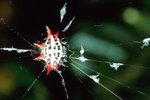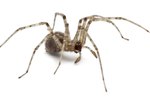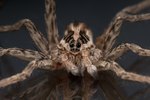
"Cotton spider" can refer to either of two different but ostensibly overlapping things. Broadly, cotton spiders are spiders who commonly live in cotton fields and prey on cotton-eating insects. Many species of these cotton spiders exist. But cotton spider is also a common name for one specific spider, the golden orb weaver, which happens to also frequently live in cotton fields. All cotton spiders are extremely important for controlling agricultural pests.
Golden Orb Weaver
The golden orb weaver is also known as the common garden spider, black-and-yellow or yellow argiope and cotton spider. This arachnid-of-many-names includes at least 35 nearly identical species of the Argiope genus,and is one of the most common spiders throughout North America. Argiope species live by the hundreds or thousands in all sorts of grassland habitats, including cotton fields. These yellow and black spiders are best known for their gigantic webs with the cottony zigzag patterns down the middle. They eat all sorts of insects, ensnaring them in their webs. Males die as soon as they mate -- the female doesn't kill them, they just succumb to pre-programmed demise as their romance reaches its climax. Young hatch from egg sacs in their mothers' webs.
Lynx Spiders
Lynx spiders are important for pest control. They love to eat cotton fleahoppers and bollworms. The striped lynx is small and white or yellow with tan or brown stripes. The green lynx is bright green with spiny legs. Both are under an inch long. Lynx spiders actively hunt and ambush their prey. Mothers carry their egg sacs and guard them vigilantly until they hatch.
Jumping Spiders
At least 5,000 species of jumping spiders exist. A 1982 survey of cotton spiders counted several dozen jumping spider species among 97 total spider species in select Texas cotton fields alone. These spiders actively hunt prey -- they do not build webs. They tend to make up a greater percentage of the total cotton spider population in hot and dry weather. Most are quite small, 1/2 inch long or less.
Crab Spiders
Several species of crab spiders live in cotton fields, but the most common -- or at least the easiest to find -- is the Celer crab spider. These small, bright-orange-and-yellow-patterned spiders do not build webs; they make tiny, silk-strand parachutes that they ride into cotton fields shortly after hatching. They're hunters and ambush predators. They have a pair of very long front legs reminiscent of a crab's claws. They eat all sorts of insects, including common cotton pests.
References
- Texas Cooperative Extension: Field Guide to Predators, Parasites and Pathogens Attacking Insect and Mite Pests of Cotton - Recognizing the Good Bugs in Cotton
- Journal of American Arachnology: Spiders in Eastern Texas Cotton Fields
- Encyclopedia of Life: Argiope aurantia - Yellow Argiope, Black-and-Yellow Argiope, Golden Orb Weaver
Resources
Photo Credits
-
Hemera Technologies/Photos.com/Getty Images
Writer Bio
Angela Libal began writing professionally in 2005. She has published several books, specializing in zoology and animal husbandry. Libal holds a degree in behavioral science: animal science from Moorpark College, a Bachelor of Arts from Sarah Lawrence College and is a graduate student in cryptozoology.



